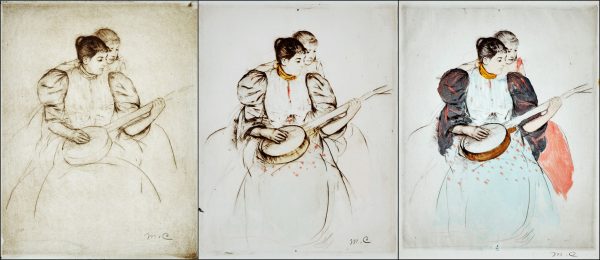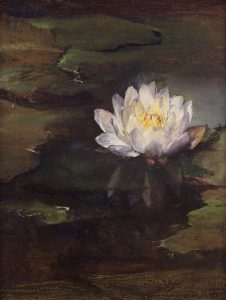Tradition Duels the Avant-Garde: American Art from a Northwest Collection
To be avant-garde or not to be—that is the question examined in concurrent exhibitions exploring late 19th-century American artworks bearing the whips and scorns of time. Assembled by the Timken Museum of Art’s new Curatorial Director Derrick Cartwright, a two-part exhibition mindfully rubs conservative art against a new tide of natural shocks. As organized, such artists as traditionalist Frederic Remington takes arms in a duel at dawn against a sea of modern insolence.

Mary Cassatt, “The Banjo Lesson,” 1893 (3 variants). Color drypoint and aquatint with monotype inking; each: 11 3/4 x 9 3/8-inches. On loan from the Ann and Thomas W. Barwick Family Collection. Images courtesy of the University Galleries, University of San Diego.
“Collections in Context: American Art from a Pacific Northwest Collection, 1860-1950” is staged simultaneously both at Balboa Park’s Timken and at the University of San Diego (USD) campus’s Robert and Karen Hoehn Family Galleries located in Linda Vista, where Cartwright is also the director of the college’s art galleries. Artworks are all drawn from the Ann and Thomas W. Barwick Family Collection and most are already partial gifts to the Seattle Art Museum where Cartwright was previously director. Both venues should be attended to comprehend the idealistic “feint” being waged between American artists from the time of the Civil war into the beginning of the 20th-century—an artistic era oft referred to as the American Renaissance.
The honor of American realism is slapped in the face by the influence of the European vanguards when Winslow Homer’s black-and-white etching “Fly Fishing at Saranac Lake” (1889) is flanked stage left by John Singer Sargent’s “Ships at Palma” (c. 1908) and stage right by a trio of different states of Mary Cassatt’s “The Banjo Lesson” (1893) in the USD galleries. Homer’s very last etching is rendered in a plain, illustrative style and depicts a stiff gentleman sitting in a rowboat holding a fly-rod in his left hand while netting a fish with his other. The etching’s qualities cannot override even the progressive hint of flatness inspired by Japanese ukiyo-e woodblock prints. Homer’s etched effort is even hollower, priggish, and wooden when staged in such sorrowful embrace by Cassatt and Sargent in the gallery. Even a grisaille (black and white) preparatory watercolor study for the etching “Netting the Fish” (1889) created by Homer in the collection of the Art Institute of Chicago featuring a dramatic range of values and visual textures would look asleep and found wanting if “corps-à-corps” to Cassatt’s etching and Sargent’s watercolor of ships.
While Sargent stood outside in the midsummer sun on the docks of Parma, Homer is outflanked by Sargent’s fervent, furious dockside made slings and arrows of puckish brushwork depicting three sailing vessels created on the spot. The artist’s brushwork in “Ships at Palma” is elegant, loose, and lyrical. Sargent is renowned for the swashbuckling oil brushwork that makes-up his famed society portraits, but he painted an even more voluminous canon of painted “en plein air” (“in open air”) watercolors during his European travels. While finding one of his oil paintings to view is relatively easy, it is a rare opportunity to be able see one of his plein air study paintings in person—making the opportunity to personally see this Sargent watercolor a rare treat.
Of Cassatt’s trio, a simple “parry” of her black and white “working proof” drypoint etching of a tutoress educating a maiden to strum a banjo also manages to foil Homer’s etched fly fishing epic. The basic image of the young tutor in white with a dark billow of sleeves along with the conscious focus in the eyes of the two maidens’ faces are tender and life force full. Better is a second state of the image, here Cassatt did add both dapples of orange aquatint below the tutoress’s waist and a choke of yellow ochre ‘round her collar. The added spare sprigs of hue breathe even more life into the inked image.
Better still, in a fourth state, Cassatt conjured the tutoress’s billowing sleeves into an indigo hue and did add more abundant orange dapples to the white dress of the fair banjo tutor. The accompanying young maiden’s white clothing found in the previous states has also been transformed to a pale orange and a moor mist of gray fills the background. The nobler Cassatt opposed the sleep of endless reproduction by also hand applying unique embellishments before printing individual version of the image—perchance in hopes of finding an undiscover’d dream come true on each and every pressing.
Other important “seconds” to the main American Renaissance duel at USD include a fardel of Pre-Raphaelite inspired watercolors by such artists as William Trost Richards and “Election Banner—Twenty-third and Broadway” (1903) by Everett Shinn, which is a pastel on paper “assault” to James MacNeill Whistler’s “Nocturnes.”
Highlights of Cartwright’s drama staged at the Timken is a bout between three visual soliloquies: Remington’s bronze “The Outlaw” (1885) and the two oil on canvases “Water Lilly” (c. late 1870s) by John La Farge and “Hemlock Pool (Autumn)” (c. 1894) painted by John Henry Twachtman.

John La Farge, “Water Lilly,” c. Late 1870s. Oil on canvas; 11 x 8 1/2-inches. On loan from the Ann and Thomas W. Barwick Family Collection. Image Courtesy of the Timken Museum of Art.
Stage right as one enters the Timken’s small gallery is American artist La Farge’s “Water Lilly.” En garde! It is a great enterprise of pitch and moment as his pioneering interest in the Japanese aesthetic has inspired a lily floating Ophelia-like in a dark green pool. This “Water Lilly” is part of his series of water lily paintings appearing from the late 1870s into the mid-80s. They are eerily similar to Claude Monet’s future floating nymphaea that the more famed Frenchman will paint much latter—by near onescore-years!
Twachtman’s “flick” from stage left consists of ethereal layers of ghost-like brushwork in “Hemlock Pool,” but it speaketh in similar manner to impressionism. American peers of the artist thought the canvas mad but madness in great ones must not be unwatch’d as “Hemlock Pool” becomes a classic “rapier” thrust against traditional American realism.
Remington’s riposte sitting center stage is a more rugged American west themed sculpture of an outlaw cowboy riding a bucking steed. The bronze stands its ground in the avant-garde fray. The dynamic horseman’s theatricality and the bronze’s golden-brown patina finish is powerful and doth showeth no cowardice. In 1907, Theodore Roosevelt said of Remington, “He is, of course, one of the most typical American artists we have ever had…” Although doubt truth to be a liar because the change in the artist’s style in his post-1903 bronzes turns awry. After 1903, such bronzes as “The Outlaw” show a richer textural finish than such earlier more academic inspired works as his Remington’s famed “Bronco Buster,” 1895. Later bronzes have a rougher finish that was influenced by the artist’s own adoption of impressionism that first began appearing in his paintings. Even the most typical American artist’s flesh was heir to the rot bourn in France.
Overall, “Collections in Context: American Art from a Pacific Northwest Collection, 1860-1950” is a worthy exhibition featuring a cry of players in an adversarial duel of ideologies pitting traditional American realism against artworks influenced by a broader, more worldly view of what art perchance might be and will become. Woe worthy royal house, America, but “touché,” avant-garde! Now, cracks a backward noble heart. Good night, sweet prince.
“American Art from a Pacific Northwest Collection” runs 8 July through 2 September 2016 at the University Galleries at USD and runs 1 July through 4 September 2016 at the Timken Museum of Art.
(The author wishes to offer thanks to William Shakespeare and his play “Hamlet” for writing inspiration as well as to Wikipedia’s “Glossary of Fencing Terms”).
Copyright © 2016 by Kraig Cavanaugh


Kraig Cavanaugh lectures about art history—specializing in Modern & Contemporary Art—as well as being an instructor of color theory, design, and studio art. He has curated numerous art exhibitions, authored exhibition catalogues, and written art reviews for several other print and online journals including “Artweek” (USA) and “Selvedge” (UK) magazines. Cavanaugh is also an invited member of the Association Internationale des Critiques d’Art (United States division), which is an NGO in official relations with UNESCO.


